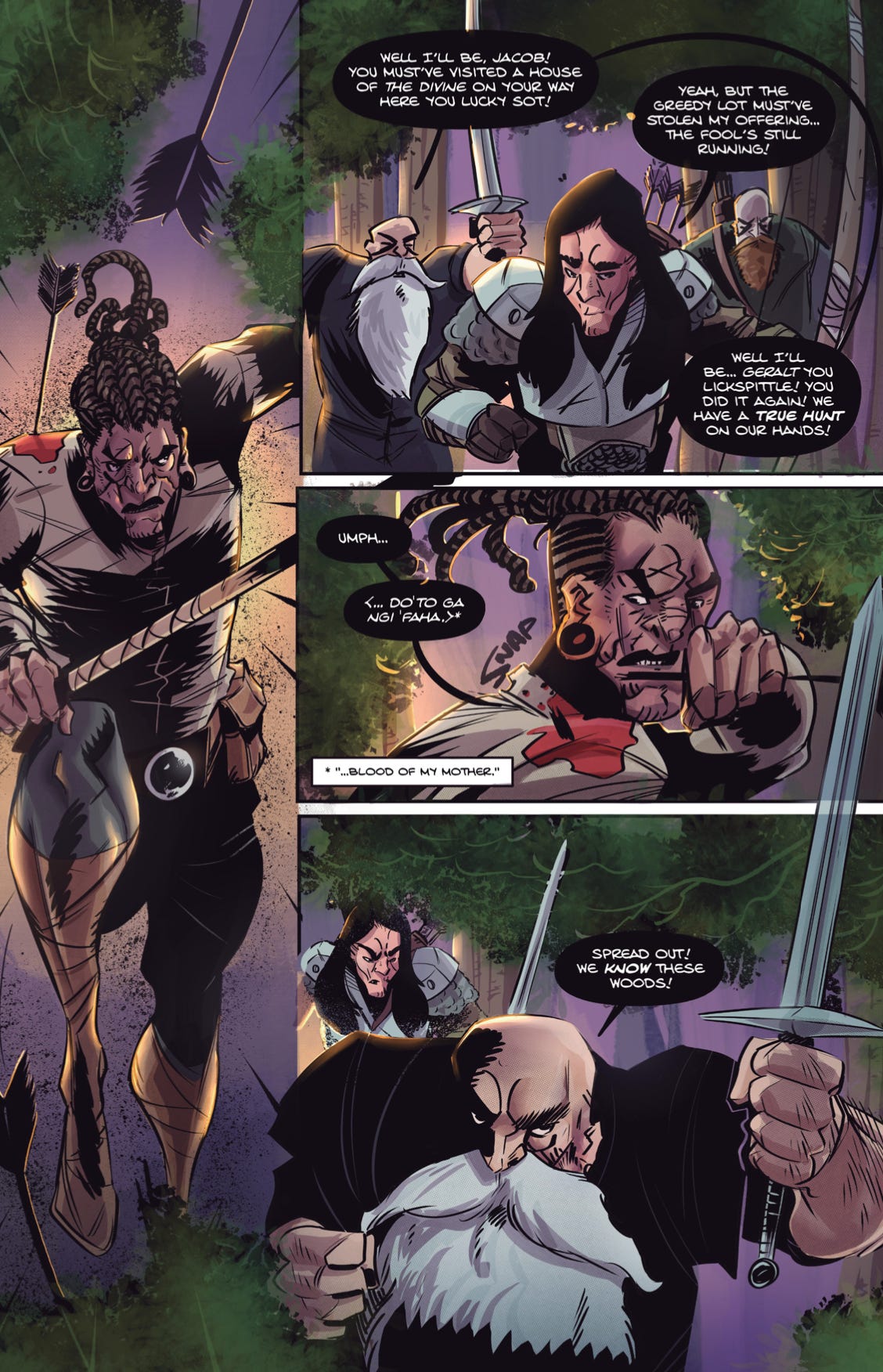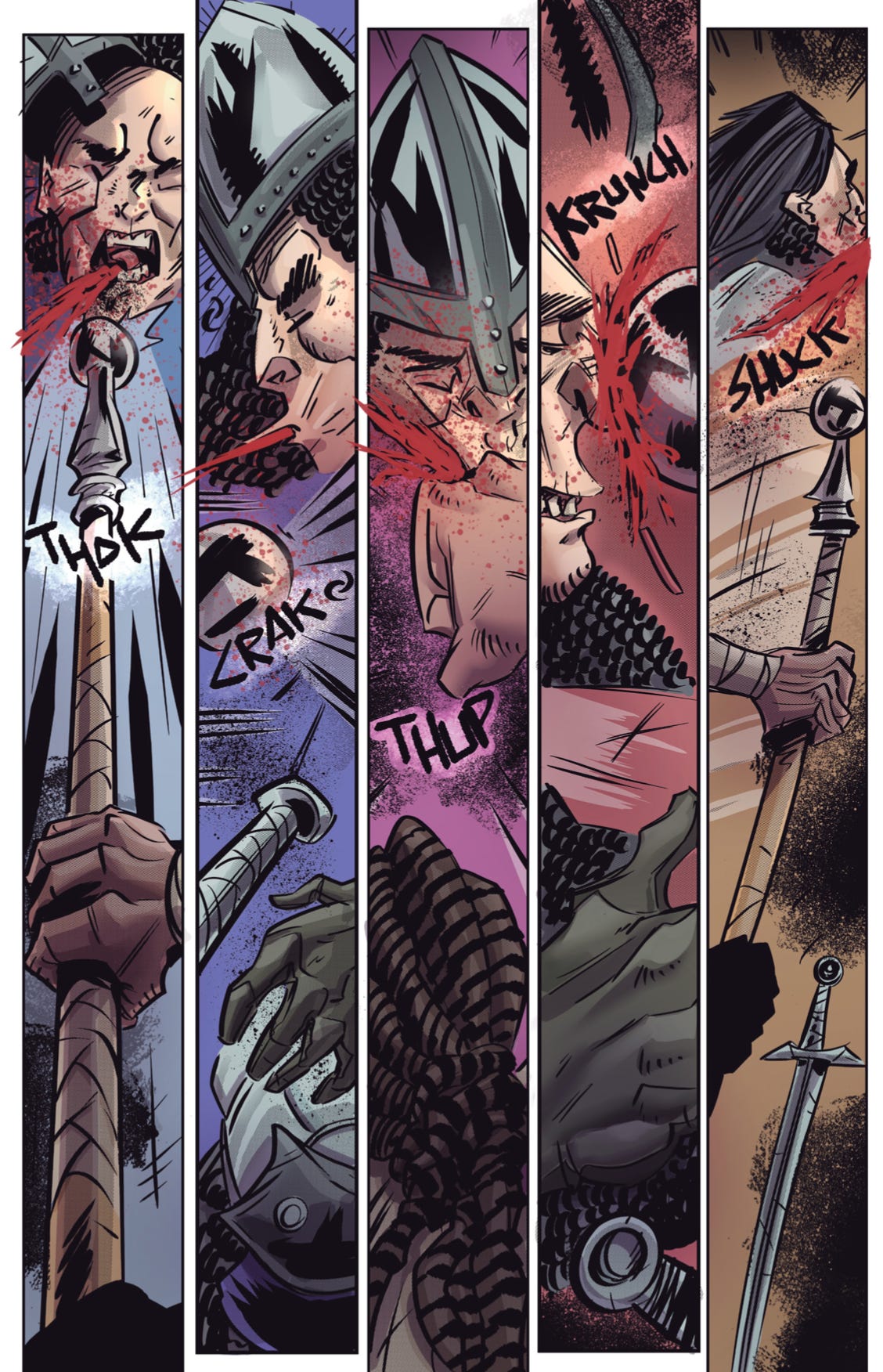Worldbuilding and The In Between
"These mental side quests lead to brand new imaginative pathways through the world being created..."
Some of my favorite moments within the fantasy genre take place in between the quests, missions, and battles.
When I crack open a new fantasy novel/ graphic novel (or hit play on an audiobook or movie) I am definitely looking forward to the “main events.” Be it the world saving magic, the tragic hero, or the foursome that travels to save the kingdom I am here for it all. Though when I’ve exited any given fantasy world I’m often driven to talk about the bits of worldbuilding that act as the glue to any quality piece of fantastical storytelling.
While constructing Ennead and the world of Amashik I had readers like myself in mind. Those who seek out aimless adventures in new worlds; the folks who love side quests and open world video games. It’s the moments in between major events and plot points that keep an audience like the one I have in mind coming back for more. Creators, make sure you know who your ideal reader is, and not just demographically. What do they enjoy? How do they seek to be entertained? Why are they going to tell a friend about your work?
All I need to enjoy a story the first time through is believable dragons and prophecies, swords and sorcery that looks cool, and at least one person to root for. If I’m going to come back, it’s going to be because of the missteps and misdeeds that were overhead in the tavern or the mysterious, and cultish, group that attacks the protagonist (*cough*). You know, the things that are hinted at but left unexplored? When done tactfully things like this add to a story’s setting in a way that feeds the narrative. These mental side quests lead to brand new imaginative pathways through the world being created in a way that make an audience feel as though they are actually there. The trick as a creator of a fantasy IP is that you need to know which segment of the audience you’re targeting.
I want the worldbuilding junkies.
When worldbuilding is done well it’s integrated seamlessly into the way characters dress, the way they talk, and the actions they take. I have a higher tolerance for info dumping than most people I come across, both in the real world and on the internet, but I recognize that it can bog a story down. So much so, that it can render some completely unenjoyable. When I look out across the fantasy genre at stories that do exposition well I notice a few commonalities:
If the characters being featured know each other and the subject matter well, it's okay if they say a few things that the audience doesn’t understand (yet). How often are you the third or fifth wheel in a conversation and left feeling like that kid who can’t double dutch but wants to try? Everything is moving so fast, the folks involved look so comfortable, yet here you are with absolutely no idea how to insert yourself.
When a new faction or individual is introduced to the story the characters to whom they are being introduced don’t hold a god-like understanding of their strengths, weaknesses, and complete historical relevance. If something is new to a character, it should be new to the audience. Sometimes a creator’s incessant need to show off what they’ve built gets in the way of good tension building (i.e. good storytelling).
While a good magic system has at least a few rules, consequences, and advantages most users won’t understand them all. Therefore, the audience doesn’t need a dissertation on the advantages and disadvantages of using glass bending.
Take anything you’re good at and ask yourself “have I really mastered every facet of X?” The short answer is likely no. I’ll use LeBron James as an example here: LeBron recently broke the all-time scoring record in the NBA. Meaning that no other human being has scored more points than he has on a NBA court. A tremendous accomplishment. LeBron has also likely never scored a basket in the NBA using the skyhook, a shot patented by the man he just passed, Kareem Abdul-Jabbar (who happens to have a Substack by the way). Even if your protagonist is the LeBron James of magic in your world, there is still more for them to learn. Good stories let the audience learn along with them.
What do these three things have in common? They respect the audience’s perspective. In stories that do one or all three of these things it’s clear that the creators took time to consider their audience. How might they feel as an outsider in a given situation? How can their, as in the audience, assumptions be used to aid the storytelling? What, if any, preconceived notions might allow for extra tension in a given moment?
For the last one, I’ll use Ennead to dive a bit deeper into the importance of worldbuilding, the audience’s perspective, and a creator’s respect for both.
As Inahtuu is being led towards this moment I take advantage of a few preconceived notions and expectations the audience might have while reading Ennead and hold the scene’s tension close to them. Here we have our protagonist, an obvious outsider, being led to a place where he’s expecting to find work. Instead, he happens upon a celebratory feast. One where no expense is being spared and where he’s clearly the odd man out.
The group he encounters is partaking in a series of hunts on a large estate, one owned by an ostensibly generous man. As the scene unfolds and things turn deadly for Inahtuu the audience is (hopefully) shocked to see a fairly high level of brutality and lack of respect for humanity that is displayed by the hunters. The “shock” relies on the three factors listed above:
The worldbuilding surrounding the group is shrouded in mystery and done largely by contrasting what they are wearing and eating to the folks met so far in Athea. Who are these people? What are they celebrating?
The audience’s attention is focused on trying to figure that out while they watch Inahtuu interact with these people who seem to be fairly different from any met thus far in the story. They seem to ignore his outside status, they welcome him in. Why?
The creator’s intention was to answer a question about the group of hunters without actually saying anything more about who they are. They are killers, clearly unified by their bloodlust. But who they are still remains an open question.
It’s this type of open question that allows this scene to work for a reader like myself; one who is interested in exploring the in between. Had I inserted a character who knew all about the true nature of the hunters it would’ve seemed forced had Inahtuu still fallen victim to them (or it would’ve completed neutered him as a character); had I inserted a character after the encounter to explain who these people truly are I’d have killed the mystery and my ability to re-visit them in the future along with it.
Now as a first time reader of Ennead you got to see Inahtuu in his element, experience a rather unsettling side of Athea, and have a new reason to continue to be invested in Inahtuu. But what’s left behind for secondary and tertiary read throughs are all the questions surrounding this group. Who are they? Do they do this kind of thing often? Is it sanctioned? Who else knows about what’s going on at the Cunningham Estates?
The fantasy genre wouldn’t be what it is without thoughtful and thorough worldbuilding. The quiet moments in between the big budget pieces are pivotal to the genre’s success and those moments are no accident. If you are looking for a fantasy saga that respects them check out the first 60 pages for free right now.
JL










I think this can (mostly) be summarized/boiled down to: "show, don't tell". And when you "tell", it can be between the lines of dialogue between characters, rarely straight up expo dumps, and let the readers connect the dots. I think you strike a great balance of this in Ennead, and I recently read Image's Black Cloak #1 which I'd hold up as a primo example as well. Check that one out when you can, it's a fantasy/modern world hybrid that somehow sets up an insane number of ideas without ever directly explaining any of them. And yet by the end of the issue, the foundations of the world are very, very clear.